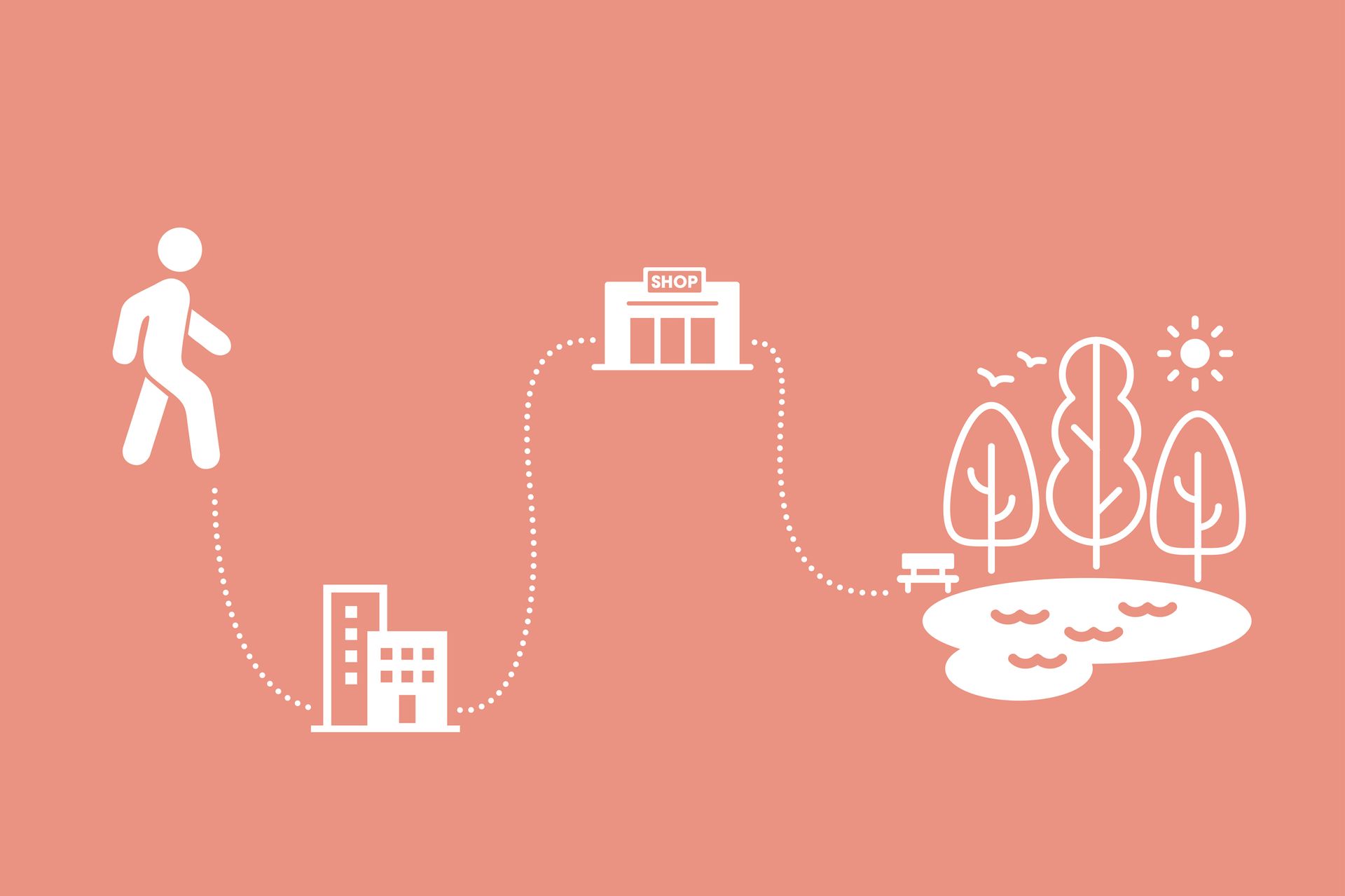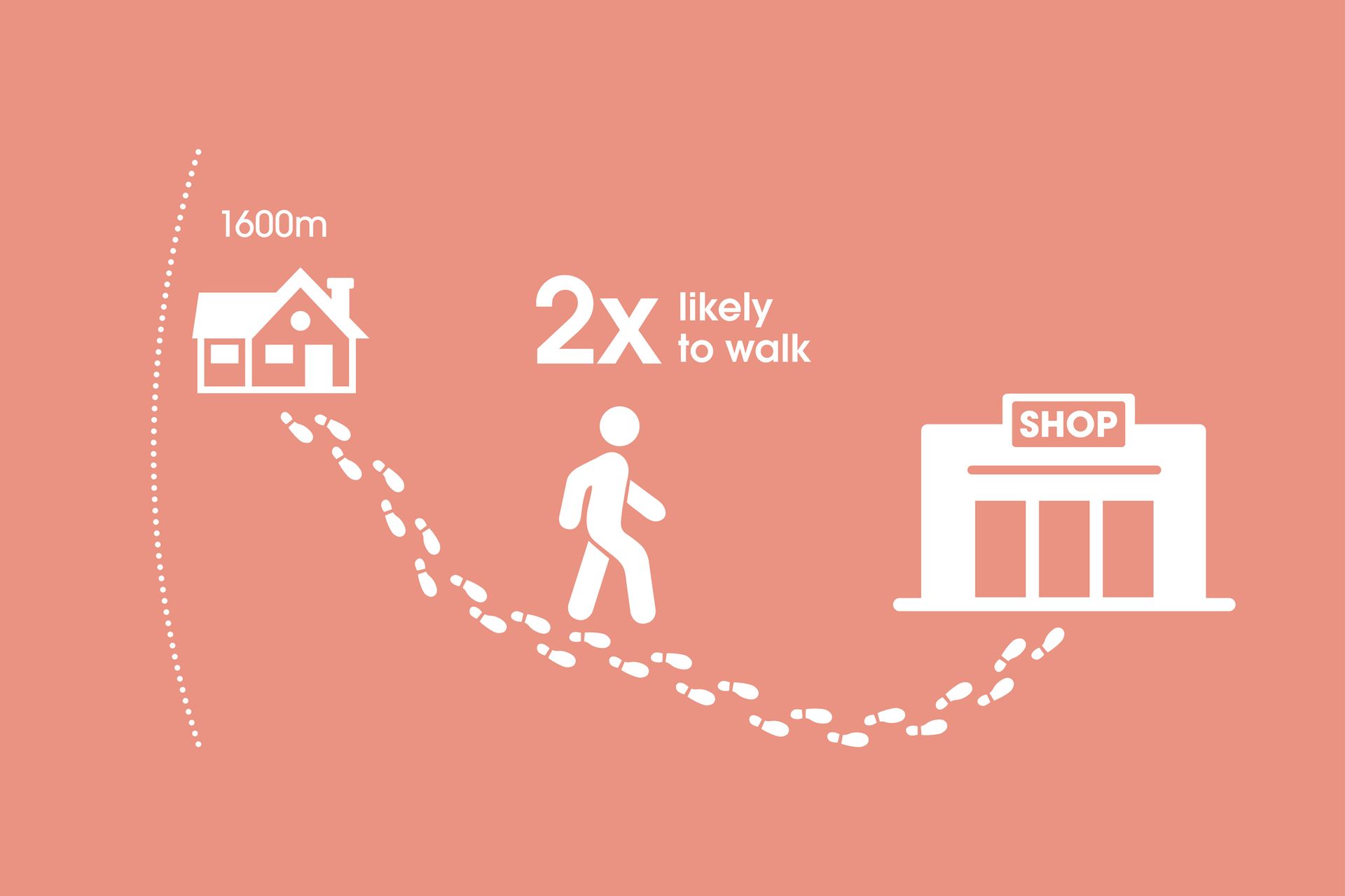Compact, diverse, mixed-use neighbourhoods allow residents to “live” within their local area: they essentially bring a village feel to a small part of a big city or town. These mixed-use neighbourhoods, at their best, include employment, recreation, education, retail, fresh and healthy food outlets all interwoven with cycling, walking and public transport access.
This section includes research on the optimum distance from a destination such as a school or park to maximise walking or cycling frequency but also best-practice design from active neighbourhoods around the world.
Author: Dr Lucy Gunn.
Detailed further guidance on this design feature is available on our
Publications and Policies page.
Living within close proximity (400-800m) of a mix of destinations is associated with higher levels of active transport (walking and cycling) across all age groups
Features and benefits of a mix of destinations
- A healthy, active neighbourhood has a good distribution of public open space.
- Dispersing several mixed-use destinations across the neighbourhood encourages walking.
- A range of land uses served by public transport provides equitable access to facilities.
- Destinations reached by interconnected paths can meet the day-to-day needs of the local community.
- Specialised research and education centres can also serve as locations for commerce, culture, arts, entertainment and innovation.
- Destinations served by public transport are important for local identity and local employment.
- Street trees, awnings and benches create an inviting pedestrian environment.
- A pedestrian-dominated civic piazza can provide a focus and help establish a strong local sense of place.
- Small spaces become destinations when people are given a reason to stay. A café, trees for shade and local artwork create an inviting place.
- Locating destinations such as shops, cafes and libraries to the main street and town centres encourages human activity and interaction. This can be further complemented by higher residential development set back from the street.
People living within 1600m of a convenience store, shopping centre or newsagent are twice as likely to regularly walk
What do we mean by ‘destinations’?
By ‘destinations’ we mean a variety of different land uses (such as shops, services and businesses) within the one location – whether that is a project area, precinct, locality, site or building – which people will make a special trip to visit. It is common for destinations to be co-located in town or neighbourhood centres.
‘Town centre’ is the term historically used for the commercial or geographical centre or core area of a town or neighbourhood. A town centre acts as a community focal point or hub, with a clustering and concentration of destinations and mixed land uses that attract people to a variety of activities, and is usually served by public transport.
Town or neighbourhood centres should include a diverse mix of retail, commercial, health, education, entertainment, cultural and recreational destinations, and community facilities. This mix is essential for creating hubs of destinations of sufficient diversity to serve as useful, walkable nodes or a regular destination for the majority of the population. A hub should include destinations or land uses that generate activity outside normal business hours and at different times of day and night (such as hospitality and entertainment, community facilities, gymnasiums).
This generates additional evening and weekend activity, and also takes advantage of shared facilities such as car parking and public transport – all important for creating vibrant, inviting and safe town and neighbourhood centres. Higher-density housing in and around the centre is also important, to support the destinations, facilities and high-frequency public transport.
Local centres also play an important role by giving communities walkable access to services and facilities. These local centres help meet people’s main daily to weekly household shopping and community needs within their walkable catchments. Local centres will typically include a corner store or deli and newsagent, but are limited in their range of shops and services.
People with access to 'main-street' centres are over 7 times more likely to walk for over an hour each week. People living within 1600m of a 'big-box' shopping centre are 3 times more likely to walk within their neighbourhood
The term ‘mixed-use development’ refers to buildings that contain a mix of uses – such as commercial, retail or other non-residential uses – maintaining an active commercial and business environment at pedestrian (street) level, often with residential dwellings on the upper levels in a multiple-dwelling configuration. [1, 2]
The term ‘land use’ describes land that has been zoned for specific purposes in a town planning scheme. These purposes can include residential, retail, commercial, civic, open space, or mixed use. ‘Destinations’ are the specific types of businesses present (such as a supermarket, hotel, cinema or bank).
The term ‘land-use mix’ is often used in the public health literature to describe the diversity (mix) of different land uses or destinations in a given area (such as within a neighbourhood). [2] Measures of ‘land-use mix’ are often computed by using geographic information systems (GIS) and include simple counts of different destination types or land uses, as well by using more sophisticated methods – such as entropy formulas that measure the variety and distribution of land uses over a given area. [3, 4]
Download the Destinations infographic
Stay informed. Sign up to our newsletter.
I agree that I have read and I accept the Heart Foundation's Privacy Statement.




